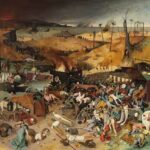![]()
A new dig in Mexico reveals the grisly fate of 550 people seized in 1520 by the Acolhua, allies of the Aztec and enemies of Spain.
The son of minor Spanish nobility, Hernán Cortés sailed for the New World at age 19, in 1504. After spending several years in Hispaniola and Cuba, he commanded an expedition in 1519 to explore Mexico. Cortés would topple the Aztec Empire in 1521, bringing Mexico under Spanish control.
Archaeologists with Mexico’s National Institute of Anthropology and History have solved a mystery: the ultimate fate of a group of travelers taken prisoner by the Acolhua in 1520. Hernán Cortés, who led the conquest of Mexico in 1520, recorded the capture but not what happened to the prisoners. A dig begun in August 2015 has shed more light on the gruesome details of their imprisonment and the last months of their lives.
In June 1520, a Spanish-led caravan of conquistadores and their allies was captured by the Acolhua, a local people who were allied with the Az- tec. Cortés had sent the con- voy from the coast at Vera- cruz to the Aztec imperial capital of Tenochtitlan, which was then in rebellion against the Spanish invaders.
The Acolhua took the group to a city named Sultepec, which was later renamed Tecoaque. The 550 prisoners included Spaniards and people of African, Mesoamerican, and Cuban descent. Reports say that there were about 50 women and 10 children. By March of the following year, not a single one was alive. But how they died was unknown.
The Bones Will Tell Previous digs initiated at Tecoaque centered on its religious life, including its temple dedicated to Mictlantecuhtli, the Aztec god of the dead. The August 2015 dig turned attention to examining the prisoners’ living conditions, the ways they perished, and the people who held them. The excavation revealed that Tecoaque was hurriedly converted into a huge make-shift jail to hold the captives, who were ritually sacrificed over a matter of months. The site supervisor, archaeologist Enrique Martínez Vargas, be- lieves that priests selected a victim every few days to se- cure divine protection against the Spanish.
At the site, archaeologists found ceramic figurines with faces bearing Spanish and indigenous features. They theorized that these objects played a part in the sacrificial ceremonies. Skeletons found in the prison cells bore signs of ritual sacrifice as well as traces of cannibalism. Marks consistent with flesh being cut away from the bones were found. But the meaning of the city’s name, Tecoaque, may be the strongest support for the cannibalism theories. When translated, the name means “the place where they ate them.”
Spanish Vengeance
When Cortés learned of the slaughter at Tecoaque, he dispatched his lieutenant, Gonzalo de Sandoval, to exact revenge. Many of the Acolhua were hunted down and killed, and their city was razed. Evidence at the site suggests the Acolhua tried to hide traces of the sacrifices as they fled from Sandoval. In several cisterns and jail cells, archaeologists found articles thought to have belonged to the prisoners. In August 1521, the Aztec Empire fell, and Cortés became governor of Mexico. The fate of the convoy was a mystery for almost 500 years.







